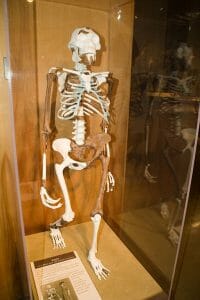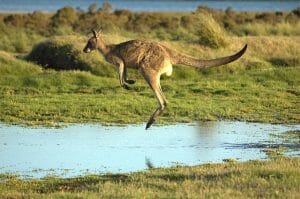In general, bipedalism refers to animals that stand and move using only two legs. Bipedal locomotion is the movement of an animal on two legs while being in an upright position regardless of whether they are bipedal to begin with. Bipedal movement can be running, hopping or walking.
Bipedal Locomotion in Humans
The earliest ancestors of humans lived in the trees and rarely traveled on the ground. Various theories have been proposed as to why these early ancestors evolved to leave the trees and eventually walk upright in a bipedal fashion. From the perspective of natural selection, researchers believe that walking upright was advantageous because it improved communication, allowed a greater field of vision and also freed up the hands for holding and carrying things as well as throwing weapons.
To determine whether an early hominid lived in trees or walked upright on the ground, scientists use four main lines of evidence which are bones from the foot, other skeletal bones, footprints and dietary evidence. The most evidence for the emergence of bipedal locomotion in early humans comes from bones, particularly toe bones (species that walked on the ground tend to have shorter toes than those who lived in trees), plantar rigidity showing that the foot was flatter, the tilt and structure of the pelvis and the way the femur fits into the pelvis. These indicators give scientists information to make assumptions about whether an animal walked upright or lived in the trees. The earliest bipedal ancestor of humans is considered to be Ardipithecus ramidus who often walked on two legs about 4.4 million years ago. Human ancestors from the Australopithecus genus are thought to be the first full-time upright walkers about 3.5 million years ago. The most famous fossil find from this genus is Lucy Australopithecus afarensis, discovered in Ethiopia and who lived about 3.2 million years ago.

The image above shows the skeleton of Australopithecus afarensis, also known as Lucy, the earliest ancestor of humans that used bipedal locomotion all the time.
Bipedal Locomotion in Other Animals
The first bipedal animal was Eudibamus, a reptile that lived about 290 million years ago. All birds are bipedal and most use bipedal locomotion to walk, escape danger and run after prey. Lizards often run bipedally on their hind legs. One example is the world’s fastest lizard, the spiny-tailed iguana. The green basilisk lizard Basiliscus plumifrons is a quadruped on land but runs on its’ two hind legs across the surface of the water. Other animals that use bipedal locomotion are hopping mice (and other rodents) the springhare, pangolins (the only known mammal that has scales covering its skin) and kangaroos.

The image above shows a kangaroo hopping using bipedal locomotion.
References
- Hirst, K. K. (Updated March 20, 2016). Bipedal locomotion: A defining trait of human beings Retrieved from https://www.thoughtco.com/bipedal-locomotion-a-defining-trait-170232
- Human and Primate Evolution. (2008). In Encyclopedia.com. Retrieved July 31, 2017 from http://www.encyclopedia.com/social-sciences/encyclopedias-almanacs-transcripts-and-maps/human-and-primate-evolution
Bipedal Locomotion
No comments:
Post a Comment